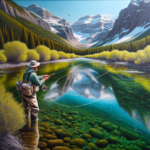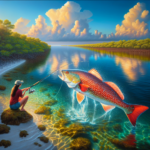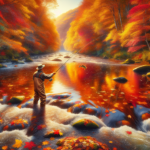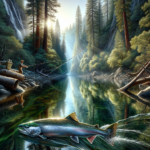Spring Fly Fishing in Montana’s Rivers

Introduction
Imagine standing knee-deep in the crystal-clear waters of a Montana river, surrounded by breathtaking mountain scenery, as you cast your line and feel the exhilarating tug of a trout. Did you know that Montana is home to some of the best fly fishing rivers in the world, attracting anglers from all corners of the globe? This article will delve into the nuances of spring fly fishing in Montana’s rivers, covering everything from the best fishing techniques and species information to top fishing spots and essential gear.
Spring fly fishing in Montana is not just a pastime; it’s a tradition steeped in history and culture. Whether you’re a seasoned angler or a novice looking to dip your toes into the world of fly fishing, understanding the intricacies of this activity can significantly enhance your experience. This guide aims to provide you with all the information you need to make the most of your spring fly fishing adventure in Montana.
Background/Context
Historical or Cultural Significance
Fly fishing has deep roots in Montana’s history and culture. The state’s rivers have been a haven for anglers for over a century, with the practice gaining popularity in the early 20th century. The cultural significance of fly fishing in Montana is evident in its literature, art, and even local festivals. The state’s commitment to preserving its natural resources has ensured that these rivers remain pristine and teeming with fish, making it a premier destination for fly fishing enthusiasts.
Geographical Overview
Montana is characterized by its diverse topography, ranging from the Rocky Mountains in the west to the Great Plains in the east. The state’s rivers, including the Yellowstone, Madison, and Missouri, are fed by snowmelt from the mountains, creating ideal conditions for fly fishing. The climate in Montana varies, but spring typically brings moderate temperatures and increased water flow, which can influence fishing conditions. The local ecosystem is rich and varied, supporting a wide range of fish species and other wildlife.
Key Points/Details
Fishing Techniques
Technique Overview
Fly fishing in Montana’s rivers primarily involves techniques such as dry fly fishing, nymph fishing, and streamer fishing. Each technique has its own set of advantages and is suited to different conditions and fish behaviors.
When and Where to Use
Dry fly fishing is most effective during hatches when insects are abundant on the water’s surface. Nymph fishing is ideal for deeper waters where fish are likely to be feeding below the surface. Streamer fishing works well in faster currents and is excellent for targeting larger fish.
Recommended Gear
- Rods: A 9-foot, 5-weight rod is versatile and suitable for most conditions.
- Reels: A reel with a good drag system is essential for handling larger fish.
- Lines: Floating lines are ideal for dry fly fishing, while sinking lines are better for nymph and streamer fishing.
- Flies: Stock up on a variety of flies, including dry flies, nymphs, and streamers, to match the local insect population.
Species Information
Species Overview
Montana’s rivers are home to several key species, including rainbow trout, brown trout, and cutthroat trout. Each species has its own habits and preferred habitats, making them unique targets for anglers.
Best Practices
To successfully catch these species, it’s essential to understand their behavior. Rainbow trout are often found in faster currents, while brown trout prefer deeper, slower-moving waters. Cutthroat trout are typically found in clear, cold streams. Using the right techniques and gear, such as matching the hatch and using appropriate fly patterns, can significantly increase your chances of success.
Location Information
Top Fishing Spots
- Yellowstone River: Known for its large trout and scenic beauty, the Yellowstone River offers excellent fishing opportunities.
- Madison River: Famous for its prolific hatches and diverse fish population, the Madison River is a must-visit for any angler.
- Missouri River: This river is renowned for its large brown and rainbow trout, making it a popular destination for fly fishing.
Regulations and Licenses
Before heading out, it’s crucial to familiarize yourself with local fishing regulations. In Montana, anglers need a valid fishing license, which can be purchased online or at local retailers. Be aware of catch limits, seasonal restrictions, and any special regulations that may apply to specific rivers or fish species.
Seasonal Considerations
Seasonal Variations
Spring is a dynamic season for fly fishing in Montana. As snow melts, river levels rise, creating different fishing conditions. Early spring can be challenging due to high water levels, but as the season progresses, conditions stabilize, making it an excellent time for fishing.
Best Times to Fish
The best times to fish in spring are typically early morning and late afternoon when fish are most active. Pay attention to local hatch charts to determine the best times for dry fly fishing.
Events and Tournaments
Event Overview
Montana hosts several fly fishing events and tournaments in the spring, such as the annual Fly Fishing Festival in Livingston. These events offer opportunities to learn from experts, participate in competitions, and connect with other anglers.
Preparation Tips
To prepare for these events, ensure your gear is in top condition, practice your casting techniques, and familiarize yourself with the event rules and regulations. Networking with other participants can also provide valuable insights and tips.
Tips and Best Practices
General Tips
- Always match the hatch by using flies that resemble the local insect population.
- Practice your casting techniques to improve accuracy and distance.
- Pay attention to water temperature and flow, as these factors can influence fish behavior.
Avoid Common Mistakes
- Avoid using the wrong fly patterns; always carry a variety of flies to match different conditions.
- Don’t overlook safety; always wear a life jacket and be aware of your surroundings.
- Respect local regulations and practice catch and release to preserve fish populations.
Advanced Techniques
- Master the double haul cast to increase your casting distance and accuracy.
- Learn to read the water to identify the best fishing spots.
- Experiment with different retrieval techniques to entice more strikes.
Gear and Equipment Recommendations
Essential Gear
- 9-foot, 5-weight fly rod
- Reel with a good drag system
- Floating and sinking fly lines
- Variety of flies (dry flies, nymphs, streamers)
- Waders and wading boots
- Polarized sunglasses
Optional Gear/Upgrades
- Fly fishing vest or pack
- Landing net
- Fly tying kit
- Waterproof camera
Where to Buy or Rent
Local fly shops in Montana, such as The River’s Edge in Bozeman and Grizzly Hackle Fly Shop in Missoula, offer a wide range of gear for purchase or rent. Online retailers like Orvis and Cabela’s also provide extensive selections of fly fishing equipment.
Safety and Conservation
Safety Tips
- Always check weather conditions before heading out.
- Wear a life jacket when fishing in deeper waters.
- Be aware of wildlife and maintain a safe distance.
- Carry a first aid kit and know basic first aid procedures.
Conservation Practices
- Practice catch and release to preserve fish populations.
- Respect local wildlife and their habitats.
- Follow all fishing regulations and guidelines.
- Dispose of waste properly and keep the environment clean.
Planning Your Trip
Accommodations
Montana offers a range of accommodations near popular fishing spots, from rustic cabins and lodges to modern hotels. Some recommended places to stay include the Yellowstone Valley Lodge near the Yellowstone River and the Madison Valley Ranch near the Madison River.
Travel Tips
Montana is accessible by major highways and airports, with Bozeman Yellowstone International Airport being a convenient entry point. Renting a car is advisable for exploring remote fishing spots. Always check road conditions, especially in spring when weather can be unpredictable.
Additional Activities
Montana offers a plethora of activities for non-fishing time, including hiking, wildlife watching, and visiting national parks like Yellowstone and Glacier. These activities make it an excellent destination for families and groups.
Frequently Asked Questions (FAQs)
What is the best time of year for fly fishing in Montana?
While fly fishing is excellent year-round, spring and fall are particularly good due to favorable weather and water conditions.
Do I need a fishing license to fish in Montana?
Yes, a valid fishing license is required for all anglers in Montana. Licenses can be purchased online or at local retailers.
What are the most common fish species in Montana’s rivers?
The most common species include rainbow trout, brown trout, and cutthroat trout.
What gear do I need for fly fishing in Montana?
Essential gear includes a 9-foot, 5-weight fly rod, a reel with a good drag system, floating and sinking fly lines, a variety of flies, waders, and polarized sunglasses.
Conclusion
Spring fly fishing in Montana’s rivers offers an unparalleled experience for anglers of all skill levels. From understanding the best techniques and gear to knowing the top fishing spots and seasonal considerations, this guide provides all the information you need to make the most of your fishing adventure. So grab your gear, head to Montana, and immerse yourself in the beauty and excitement of fly fishing in one of the world’s premier destinations.
Whether you’re looking to master a new technique, explore a new location, or simply enjoy the tranquility of nature, Montana’s rivers have something to offer. Happy fishing!




